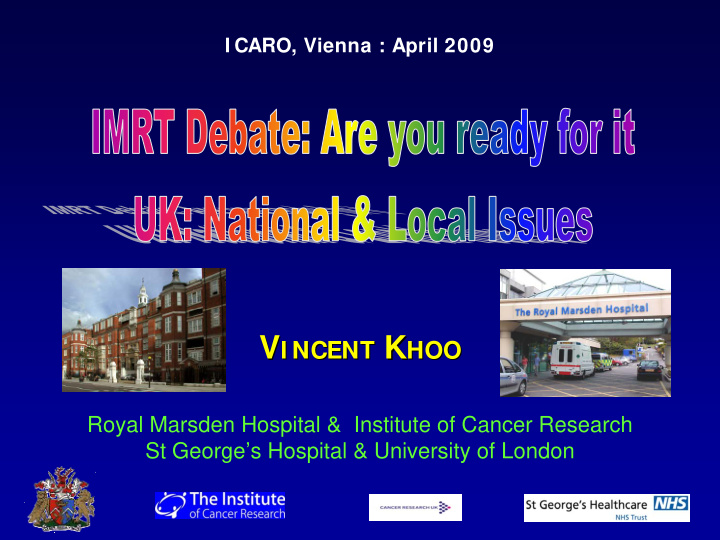



I CARO, Vienna : April 2009 V I NCENT K HOO V I NCENT K HOO Royal Marsden Hospital & Institute of Cancer Research St George’s Hospital & University of London
Outline • National Developments for RT in the UK • Current general position for RT in the UK • National Survey – IMRT/IGRT in the UK • Development Issues in the UK • Summary
UK: National RT Advisory Group • 6-2004 (Prof M Richards) • Membership – Clinicians, Radiographers, Med Physicists, relevant professional representatives, patients • Terms of Reference – Advise development and delivery of RT services incl. NHS Cancer Plan & NICE guidance – Advise RT policy programmes • Demand and capacity for RT • Requirements: Equipment, training, workforce • Service delivery streamlining, quality • Future developments • Plan: Effect a world class RT service for UK
NRAG Report 1 • 2007 • Should be • 2016 • 1.5m # / yr • 2.5m # / yr • 2.9m # / yr • 30,000 # / 10 6 • 48,000 # / 10 6 • 54,000 # / 10 6 Work I ncrease of 91% • Interim aim: 40,000 # / 10 6 by 2010/2011 • 2005: 8/39 RT centres are achieving this Ministers DoH Report, 2007
NRAG Report 1 • 2007 • 2010/2011 • 2016 • 8000 # / Linac • 8300 # / Linac • 8700 # / Linac • Each Linac 4-4.5 # (pat treatments) / hour • Linacs run 9.2 hrs/day with some at 11.5hrs/ day • RT departments operate 239 days/ year – Standard 5 day week – Close for only 3 bank holidays – Each linac with ≤ 19d QA/service during normal working hours • Incorporate a service efficiency Linac – Additional Linac in use 50-75% of time to cope with capacity peaks, other linac breakdown etc • Operate services at 87% capacity so room for more Ministers DoH Report, 2007
NRAG Report 2 • Maximum RT wait = 31 days • Maximum patient journey time = 45 min • Linac replacement = 10 years • Software & IT replacement = 3-5 years • 4D methods (IGRT) as minimum Ministers DoH Report, 2007
National Survey 2007: RT Planning & Delivery • Questionnaire response: 48/58 (83%) • 46% use IMRT • 27% use IMRT in routine management • 19% use IMRT routinely in research • 21% planning to initiate IMRT by 2008/2009 • 8% use IGRT in routine management • 12% use IGRT in research setting • 25% planning to initiate IGRT by 2008/2009 Jefferies et al Clin Onc 2009
National Survey 2007: RT Planning & Delivery I MRT Usage Centres & Subsites: Usage Centres & Subsites: Technique Jefferies et al Clin Onc 2009
National Survey 2007: RT Planning & Delivery I GRT Usage Centres & Subsites: Usage Jefferies et al Clin Onc 2009
National Survey 2007: RT Planning & Delivery Training I ssues • Radiology input for TVD – 13% had some input – 8% had occasional input – Average time for department 0.5-1.8 hrs/wk • Structured training for image interpretation – Oncology trainees: 4% (6% informal) – Radiographers: 16% (in-house), 8% (MSc module) – Physicists: 8% anatomy course, 2% (MSc module), 4% (informal) Jefferies et al Clin Onc 2009
National Survey 2007: RT Planning & Delivery Training I ssues • Radiographer structured training – 12 centres (25%) • Physicist structured training – 4 centres (8%) Jefferies et al Clin Onc 2009
National Survey 2007: RT Planning & Delivery Cited Reasons for Lack of IMRT/IGRT Uptake The 5(6) L ’s of Non-RT Development • Lacking Staff • Lacking Equipment • Lacking access to equipment • Lacking Time • Lacking Funding • Lacking Training
Cancer Reform Strategy Service delivery Governance •Workforce •Clinical Pathways •Access •Safety •Capacity •Tech assessment •equipment •Peer review •facilities NRAG Commissioning Wider world •Framework •Survivorship •contracts/service •Leadership •tariffs •Communication •toolkit •Collaboration •Data set collection •Studies •Provisions for progress DoH, 2008: www.cancer.nhs.uk
Summary Google Earth
Recommend
More recommend